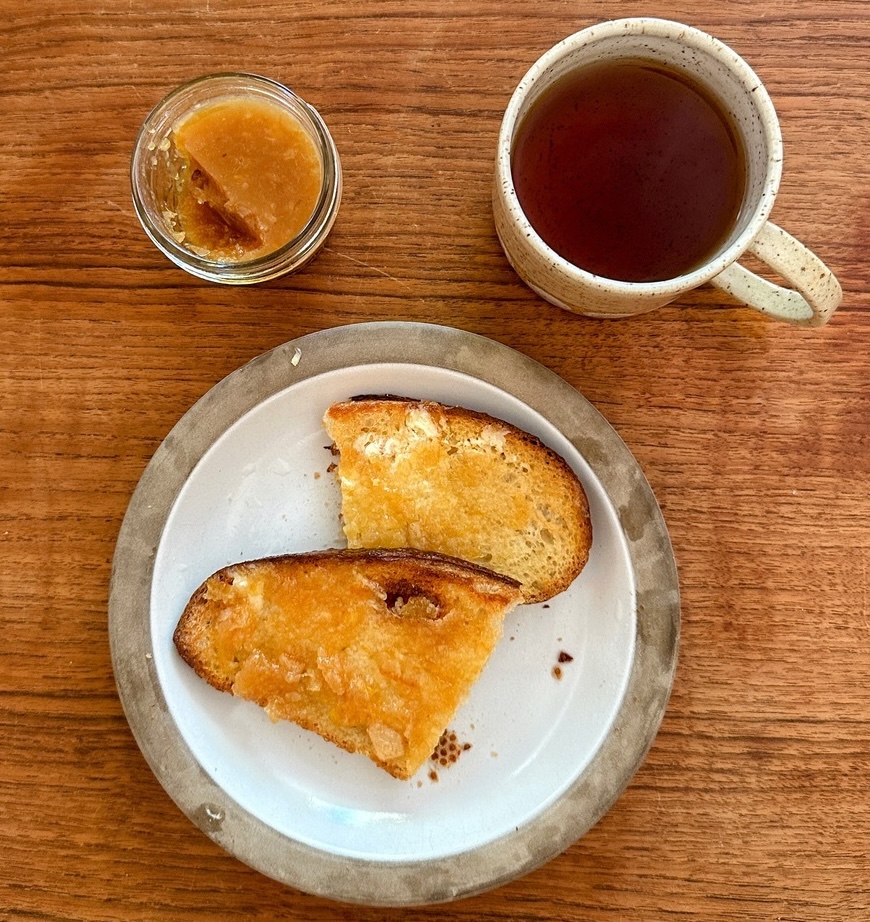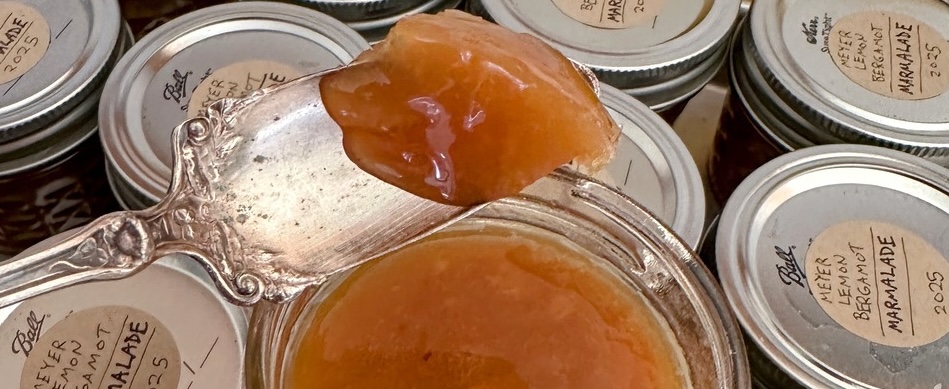I’m reasonably happy with how this marmalade turned out, tart, sweet, lemony, but not especially bitter.
I took a few jam-making books out of the library, and found Jam Session and The Blue Chair Jam Cookbook most informative:
It started with a 16-pound backyard Meyer Lemon* harvest and a good wash-and-scrub:
I decided to only use 6 pounds for the marmalade, and juiced, zested, and froze the rest of the lemons in ice cube trays, for summer lemonade…
(*side note: I say Meyer Lemons everywhere here, but I also picked one bergamot and a handful of kumquats from the yard, which I mixed in)
I spent quite a while hand-slicing the lemons and removing the seeds (I tried a mandolin but they were too soft). In retrospect, I probably could have used the KitchenAid to roughly chop them instead, and just hand-sliced a few sections to decorate the top of the jars with.
I covered them with water to twice their loose-packed height, and simmered them to soften, about an hour. It was evening, so I covered them and let them sit on the stove overnight. Note: There was still a lot of liquid: in the future I might add less water to save time during the next step.
The next morning, I put a stack of small metal spoons on a plate in the freezer for later testing.
I added about 2/3 the citrus weight in sugar (4 lbs), and brought them back to a boil. I periodically checked the temperature– initially it plateaus at 212F as the boiling point of water, but as the water evaporates, the sugar concentration rises and the boiling point increases. I’d read that 215-220F (and being careful not to go above 220F) is a good target to end up with a marmalade that will set firm when cooled but not have a rubbery texture.
Once I reached 215F (which took about two hours, longer than I’d expected, but I still had a lot of water to boil off), I started to do the “spoon test” every few minutes:
I’d pull one cold spoon out of the freezer, drop a dollop of marmalade onto it with another spoon, then return it to the freezer. I took it back out after a minute or two and checked how well the cooled marmalade had set by turning the spoon vertically and seeing if the marmalade runs off the spoon.
The first three times I tested this (at 215, 216, 217F), the cooled marmalade was still liquid and ran off the spoon.
However, when the marmalade in the pot hit 218-219F, the marmalade passed the test and set on a chilled spoon:
From here, it was just a standard water-bath canning process:
- Boil enough water in a canning kettle to fully cover the jars I’ll be using, plus at least another 2" of headroom (not having enough water depth above the jars has lead to poor sealing)
- Sterilize empty jars: in my case, I baked them in a 300F oven for 20 minutes, then left them in the oven at 250F until I filled them. I could have also boiled them in the canning kettle for a few minutes which is what I usually do, but that’s a bit more awkward when using 24 jars.
- Bring water to a light boil in a small saucepan and slide jar lids into it
- Fill these warm jars with a canning funnel, add lids and rings
- Process them in boiling water for 10 minutes (I leave the kettle partly covered so I can see it’s simmering but don’t evaporate too much of the water), then let them rest in the water bath another 1-2 minutes
- Set them on a baking sheet on the counter and don’t touch them for 12 hours
- Check that they’ve sealed
- Add labels, as usual
Within a few hours I had 100% success rate in jars sealing (and weeks later, they’ve all kept their seal).
The next morning, with toast and tea:


Overall, this was a success.
The two things I’d consider doing differently next time:
- Trying to maintain a lighter yellow color– I assume the darker color is due to caramelization of the sugar. So perhaps if I started with less water and could boil it for less time, the end result would be lighter?
- Reserving some neat, thin slices of meyer lemon that haven’t been boiled for quite as long, to place on top of the marmalade in the filled jars as an attractive surface when first opened.